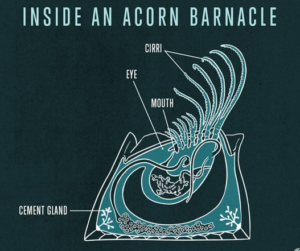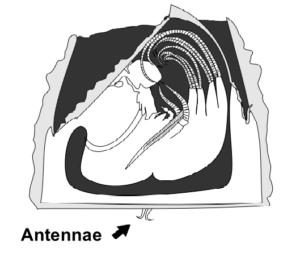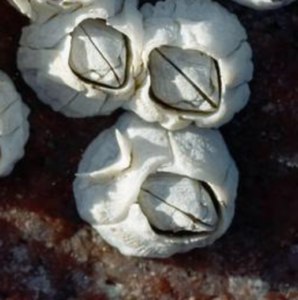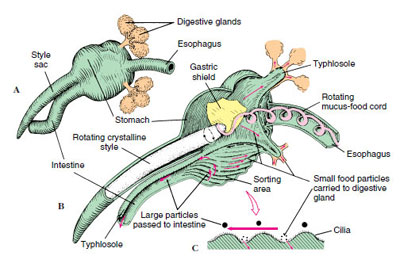
Barnacles in Barnegat Bay
Barnacles Order: Sessilia Family Balanidae
Barnacles are small crustaceans that are arthropods and closely related to the blue crab.
World wide about 1,000 species are currently known.
Barnacles are encrusters (form a crust), attaching themselves to a hard surface.
They are sessile, attaching to and growing their shells directly onto a substrate.
The most common in the bay are acorn barnacles.
Acorn Barnacles Semibalanus balanoides
 Acorn barnacles are filter-feeding crustaceans that live attached to hard surfaces.
Acorn barnacles are filter-feeding crustaceans that live attached to hard surfaces.
They are small, up to about 3/4 in in diameter, and are whitish to gray in color.
During the spring and summer, planktonic larvae settle onto a rock. They then “glue” their heads to the hard rocky surface.
During the winter and spring, they brood fertilized eggs within their shells. Depending on the size of the parent, 1,000 to 30,000 nauplius larvae are produced per brood.
 When they are ready to settle down, they search for a suitable site, pulling themselves along by the adhesive tips of their antennae.
When they are ready to settle down, they search for a suitable site, pulling themselves along by the adhesive tips of their antennae.
Cement glands within the antennae produce the brown glue that fastens the barnacle to the substrate.
Fun Fact – Barnacles are hermaphrodites possessing both male and female reproductive organs, however, they do not reproduce via self-fertilization.
 In Barnegat Bay and surrounding waters barnacle behavior is governed by the tides.
In Barnegat Bay and surrounding waters barnacle behavior is governed by the tides.
Acorn barnacles live in the intertidal zone (the area between the high tide and low tide levels) and therefore needs to be able to survive long periods outside of the water.
The shell can be closed tightly to prevent desiccation (drying out)
 Barnacles feed using 6 pairs of feather-like feet called “cirri.” The cirri are also used for breathing.
Barnacles feed using 6 pairs of feather-like feet called “cirri.” The cirri are also used for breathing.
Normally, barnacles feed on phytoplankton, zooplankton and dertitus (dead organic material).microscopic plants and animals in the water.
Each of these feathery structures (cirri) is lined with sensory hairs that comb the water for plankton to sweep into the mouth..
Fun Fact – Relative to its body size, the barnacle has the largest penis in the animal kingdom.
Credits
https://www.earthtouchnews.com
Oceana – Protecting the World’s Oceans
Rocky Intertidal Habitats Along The Coast of Maine

